Windows automatically checks for issues like Windows Update, network firewall, and Windows troubleshooting and then sends you a message if it finds something. However, sometimes, it sends necessary and redundant messages, making us want to disable the notifications. In this post, we will learn how to turn off Security and Maintenance notifications in Windows 11/10.
What are Windows 11/10 Security and Maintenance messages
Windows 11/10 uses the Security and Maintenance applet to keep you informed of issues that pertain to your computer’s health. The screen divides issues into the Security and Maintenance sections.
To open the Security and Maintenance applet, type Security and Maintenance in the Search box on the Windows taskbar and select it from the result.
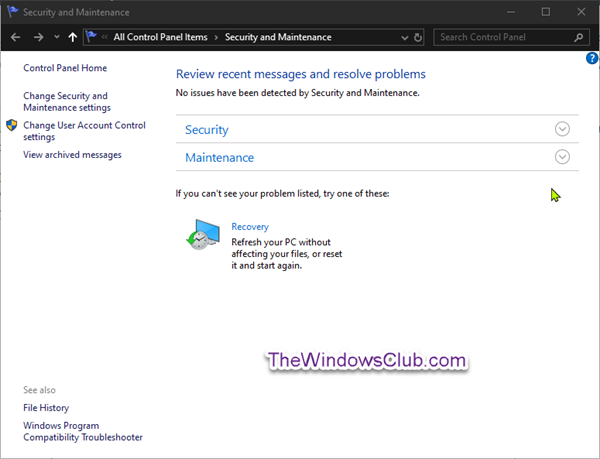
Note any messages displayed under Review Recent Messages and Resolve Problems.
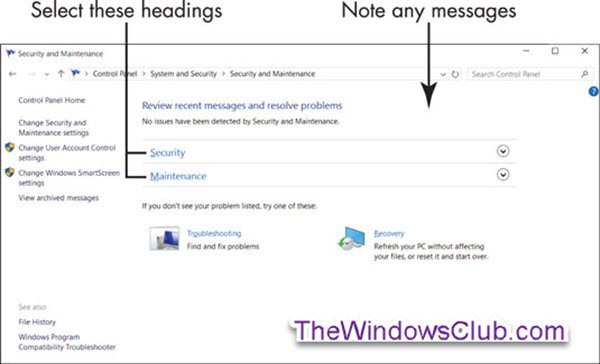
Normally, you see No issues have been detected by Security and Maintenance. So, if you see a message concerning a specific problem, select that message for more information.
The Reliability Monitor can help you pinpoint problems with hardware and software.
Next, select the Security heading in the Security and Maintenance window.
That section expands to detail security functions. Every option should display On or OK.

Brief description of each item under Security
- Network Firewall: The firewall scans Internet traffic and blocks activity from programs that don’t have explicit permission to use Internet access. When you install a program that uses the Internet, you may be asked to approve the connection the first time. The safest practice is to reject online connections that you don’t initiate or recognize.
- Virus Protection: Having virus protection for your computer is essential. Windows Defender provides antivirus protection, although you can install some other antivirus program.
- Internet Security Settings: These settings pertain to your browser. The default settings may be adequate.
- User Account Control (UAC): This function notifies you of programs that try to make changes to your system and requires that you confirm any such changes. In particular, UAC lets you know when a program tries to run or install software that may be malicious. When in doubt, say No or Cancel to UAC messages.
Next, select the Maintenance heading to see what that section includes (see screenshot below).
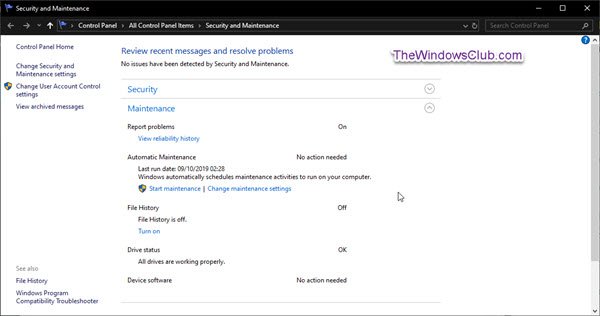
Brief description of each item under Maintenance
- Report problems: This setting is on, allowing Windows 11/10 to regularly check for solutions to problems it uncovers.
- Automatic Maintenance: Your computer automatically performs critical updates, security scans, and diagnostics each day.
- File History: File History is off by default.
- Drive status: Drives are hard disks inside or attached to your computer. Your documents, photos, and Windows 11/10 itself are stored on one or more drives. Ideally, the drive status is All drives are working properly.
- Device software: If a device on your computer needs a driver or other type of software to run properly, you are alerted here. Select Install Device Software to install the software.
Turn Off Security and Maintenance notifications
You can enable or disable Security and Maintenance notifications in Windows 11/10 using the following methods.
- Disable the notifications using the Security and Maintenance Control Panel applet
- Disable the notifications using the Group Policy Editor
- Disable the notifications using the Registry Editor.
Let us see how to do this.
1] Disable the notifications using the Security and Maintenance Control Panel applet
To open the Security and Maintenance window, type Security and Maintenance in the Search box on the Windows taskbar and select it from the result.
Click Change Security and Maintenance settings link on the left side.
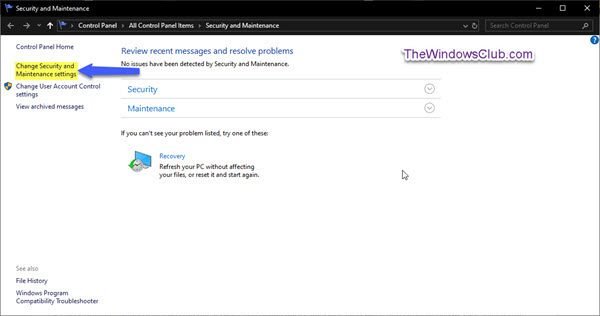
Check (on) or uncheck (off) the security and maintenance messages you want, and click OK.
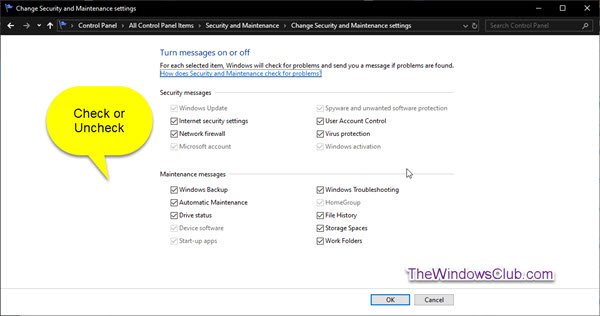
You can now exit the Security and Maintenance window.
2] Disable the notifications using the Group Policy Editor
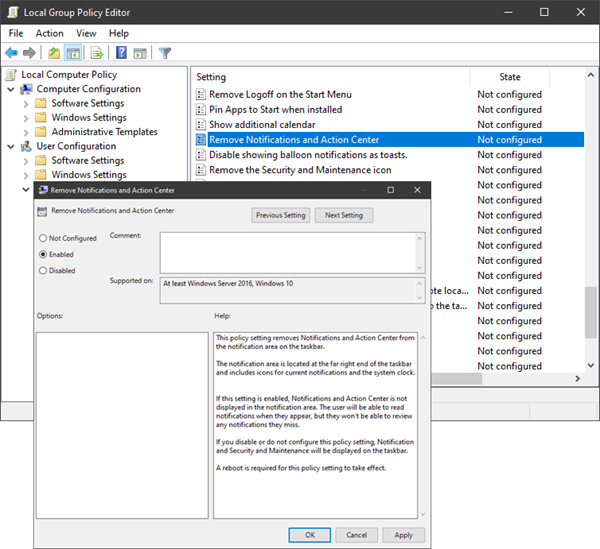
Run gpedit.msc to open the Group Policy Editor and navigate to the following settings:
User Configuration > Administrative Templates > Start Menu and Taskbar
Double-click on Remove Notifications and Action Center and set it to Enabled.
This policy setting removes Notifications and Action Center from the notification area on the taskbar. The notification area is located at the far right end of the taskbar and includes icons for current notifications and the system clock. If this setting is enabled, Notifications and Action Center is not displayed in the notification area. The user will be able to read notifications when they appear, but they won’t be able to review any notifications they miss. If you disable or do not configure this policy setting, Notification and Security and Maintenance will be displayed on the taskbar. A reboot is required for this policy setting to take effect.
3] Disable the notifications using the Registry Editor
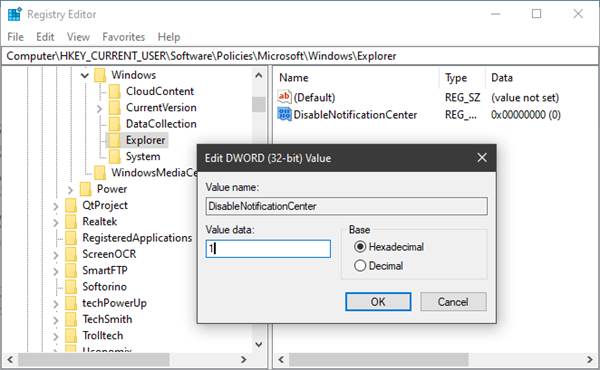
Run regedit to open the Registry Editor and navigate to the following key:
HKEY_CURRENT_USER\SOFTWARE\Policies\Microsoft\Windows\Explorer
Right-click on Windows > select New > Key. Name it as Explorer.
Now right-click on Explorer > select New > DWORD (32-bit) Value.
Name it DisableNotificationCenter. Next, double-click on it and set its value to 1.
If Explorer does not exist, you need to create it.
Hope this helps!
Read: How to grant or get Elevated Privileges in Windows 11/10
How do I turn off administrator notifications in Windows 11?
You can turn off the administrator notifications In Windows 11 using the Group Policy Editor. So, open Gpedit from the Start Menu, then go to Computer Configuration > Windows Settings > Security Settings > Local Policy > Security Options, and look for User Account Control: Run all administrators in administrator approved mode. Once you find the policy, double-click on it to open, and then select Enabled. Finally, click Apply > Ok and reboot your computer.
Also Read: Allow Standard users to Run a Program with Admin rights.